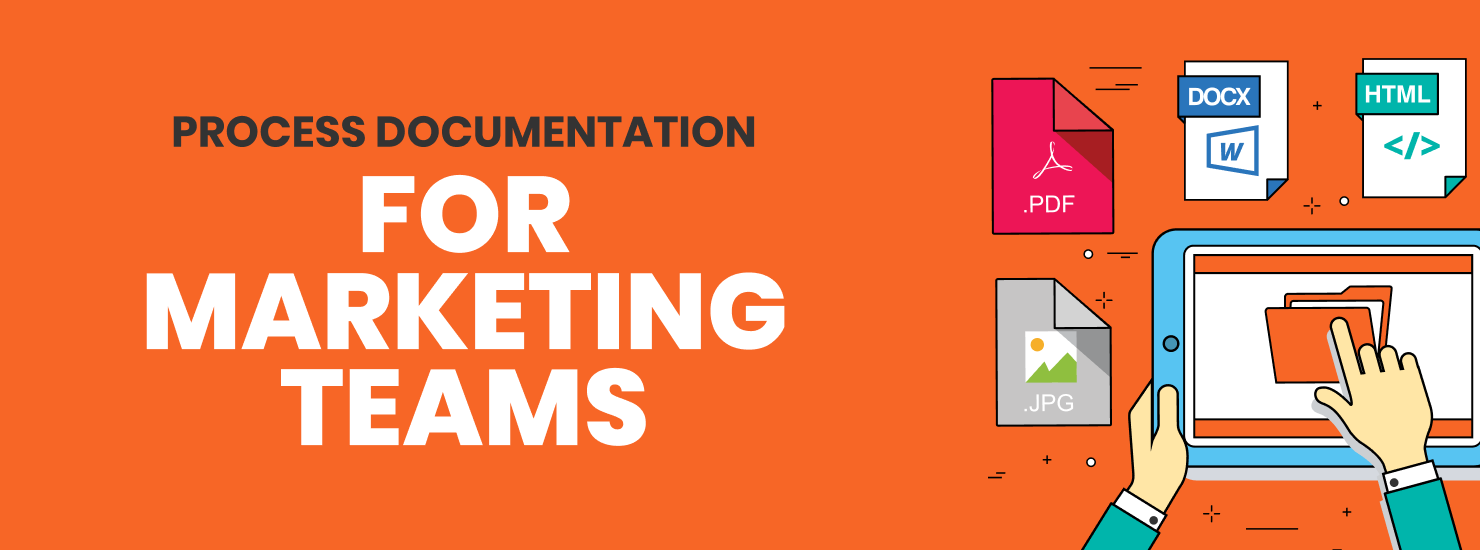Why process documentation is important
When we’re away from our normal office routine, it’s surprisingly easy to shirk our normal day-to-day processes. Perhaps a client conversation was once recorded entirely on project management software, but now quick texts or private Slack messages are more prevalent. While disregard for formality may seem harmless, and possibly more convenient, an important step is lost when marketing teams start to circumvent normal communication routes: process documentation.
Documentation is important for all business processes, not just communication. You can document social media processes, content marketing processes, sales processes, and so much more. Put quite simply:
“Process documentation is meant to capture everything you need to make your business consistent, whether it is for short-term or long-term outcomes. Documentation can guide you if the same requirement arises again, so you do not have to reinvent the wheel.” – Smartsheet
When done correctly, documentation enables managers and team leaders to better support their team, sets expectations, and helps produce successful outcomes. So, how can you use process documentation when managing your marketing team from home? Let’s jump in.
Table of Contents
- What is process documentation?
- How process documentation helps marketing teams
- Content marketing documentation
- Process documentation best practices
What is process documentation?
Quite simply, process documentation is some sort of guide that you create that outlines all of the steps necessary to complete an action. This could be anything from writing a blog post to setting up an email workflow. You name it, it should be documented.
Your documentation can take one of many forms—policies, checklists, tutorials, forms, videos, screenshots—whatever works best for your team and the specific process being outlined. That’s it! Just make sure your documentation is thorough, accurate, easy to understand, and accessible to your entire team. We’ll talk more about documentation best practices further on in this blog post, but for now, let’s discuss how it helps marketing teams.
How process documentation helps marketing teams
As a leader, you want to make sure that your marketing team has every tool and resource they need for success. Whether you’re onboarding new team members, or you’re managing a weathered team of pros, it’s crucial to provide the support everyone needs to do their job well. This is especially important now that we’re all working remotely—miscommunications and small mistakes are all too common.
A few ways you and your team will benefit from documentation, according to Smartsheet, include:
- Reduced risk of errors
- Decreased time to complete a task
- Lower costs
- Improved efficiency
- Increased quality
- Heightened customer and employee satisfaction
Pay particular attention to the last bullet point—improved customer and employee satisfaction. Hannah Paterson, Raka’s Director of Client Services, agrees:
“The success of any team relies on process. It promotes efficiency and streamlines efforts. When processes are documented and followed, it creates a better experience for both the internal team as well as clients.”
When your team understands the process to accomplish a task, and has all the tools to do so, they are much more likely to finish the task quickly and successfully. Employees feel supported and empowered to do their job and do it well, leading to greater job satisfaction. At the same time, clients are also much more likely to be pleased with results and offer positive feedback. It’s a win-win for both your team and your clients.
By taking the time to document key processes for your marketing team, you’re ultimately saving hours of extra effort down the road and aligning your entire team towards the same goals. And that’s really what being a leader is all about, right? Process documentation helps managers like you set clear expectations and assists your team in meeting them.
Content marketing documentation
If you’re looking for some ways to better support your remote marketing team, start by documenting your content marketing processes. Possibly the most crucial way to help your marketing team is to record your content marketing strategy. This ensures that your entire team is on the same page as they plan, produce, and distribute content on your blog, via email, and through social channels.
HubSpot outlines some key questions you should ask yourself when you go to document your marketing strategy:
- Why are we utilizing content marketing as a strategy?
- Who are we trying to reach with our content?
- What are we hoping to accomplish?
- How does this fit into our overall marketing strategy?
- How will we measure success?
Your answers—for your own business and all of your clients—should be documented for your entire team to review. This will help them focus their content marketing efforts on a common goal for each client and your own business.
Other important content marketing processes to document are a little more technical. Record steps for writing content, proofing it, and how to add that content to your blog, email template, or social media. For example, document the steps for uploading a blog post to WordPress. Detailed instructions eliminate a lot of research time, headache, and potential mistakes for most platforms your team uses on a regular basis.
Process documentation best practices
When you record your content marketing process, don’t just leave it and forget it for years on end. Process documentation is an ongoing process—consistently review it for mistakes and ways to optimize.
“One of the biggest mistakes you can make is setting the process and then leaving it alone. You need to monitor the effectiveness of the process over time and identify ways to improve it. That said, changes shouldn’t be a one-time exception just to cut corners. There should be thoughtful consideration and stakeholder involvement to agree on the continuous improvement of the process.” – Hannah Paterson, Director of Client Services at Raka
Perhaps you realize that the steps your marketing team currently takes to write and schedule social posts is more time-consuming than it needs to be. Use this opportunity to work with the team to come up with a solution and revise the documentation. We recommend reviewing your documentation at least once per year for best results.
There are plenty of other best practices to keep in mind as you document processes which will set your team up for success, but here are a few of our favorite here at Raka:
- Keep documentation simple and concise. It should be easy for anyone on your team to follow, whether they’ve been with your company for a month or 10 years.
- Separate documentation for every single process to help avoid confusion among team members.
- Save your process documents somewhere that everyone has easy access to, like HubSpot Documents in Sales Hub or a collaboration tool like Atlassian.
- Be sure that all documentation complies with existing standards in your business.
We understand how difficult it can be to suddenly shift your entire team to working from home. Here at Raka, we’ve been lucky enough to have years of remote work experience under our belts, and we’ve learned a lot from it. By and far, one of the best tools to make remote work successful is process documentation. No matter where our marketing team is, we always have what we need to be great at our jobs.






